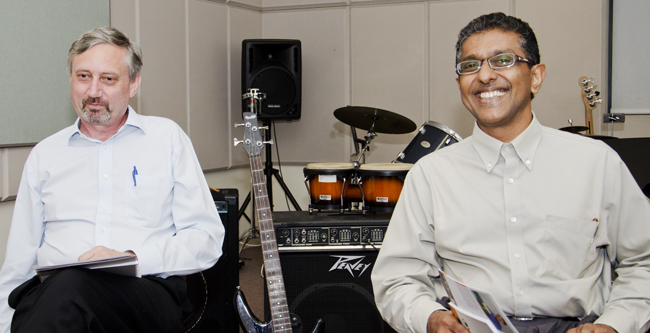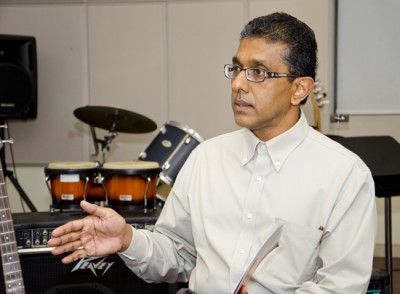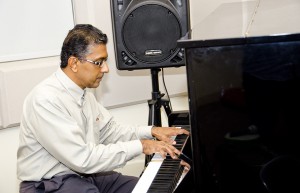Why Singapore’s English Teachers Should Embrace Singlish, Not Fight It
Is it time for Singaporean educators to embrace Singlish as a legitimate learning tool? What the Research […]
Read More
Learning and making music is more than just a recreational activity. NIE researchers believe it can facilitate learning and encourage creative expression. They are singing the praises of music education.
“Look at that child! I did not teach that!” exclaimed one music teacher, who found one of her students playing a tune he had improvised on his own. What happened in this music classroom can happen in yours too.
Eugene Dairianathan and Eric Peter Stead believe that music is more than just a recreational activity, or about honing talent. It is a subject that can help to develop critical thinking and shape creative expression.

“Music may not be an assessable component in the way Maths, Science or English are, but it has the ability to teach skills students can use in other subjects,” says Eugene, who is Head of NIE’s Visual and Performing Arts Academic Group (VPA).
Music shouldn’t be thought of as belonging to just the affective domain. In fact, music involves many cognitive skills, such as creative and critical thinking, which are linked to academic disciplines.
For Peter, a Senior Lecturer with VPA, music is a vital part of the growth and development of a 21st century learner.
“If you refer to Howard Gardner’s theory of multiple intelligences, he cites musical intelligence as a specific intelligence,” Peter explains. “It is about knowing the world. It helps to holistically educate our students.”
multiple intelligences, he cites musical intelligence as a specific intelligence,” Peter explains. “It is about knowing the world. It helps to holistically educate our students.”
But music teachers may be more comfortable with a “teacher-controlled curriculum”, where the teacher is seen as the instructor. However, for such a creative and expressive subject like music, Eugene and Peter encourage teachers not to limit learning.
In the course of their research, they saw how teachers can create a space that facilitates their students’ learning. If carefully done, it allows ownership of the learning to return to the learner. What teachers need to do is deliberately relinquish some control.
For example, when teaching students about the fundamentals of beat or rhythm, the teacher can illustrate it by demonstrating a series of finger clicks and hand claps and then getting the students to repeat it.
However, that’s where the instruction ends and facilitation continues. The teacher can then ask the students to create their own personal beats. Not only does this require the application of cognitive skills, it shifts agency from the teacher to the students, making learning more authentic.

Eugene recalls one teacher who believed in maintaining control over the class. “Being encouraged to relinquish control caused her some consternation. But in giving some agency back to the students, she found that students could learn on their own.”
She told the research team that by letting go and letting her students discover things by themselves, they learned transferrable skills that could be used in other subjects.
“Rather than losing control in the class – and losing learning – she found that she gained learning because the students themselves, by being given ownership, took upon themselves the intrinsic motivation to get the job done,” Eugene notes.
Seeing the benefits of relinquishing some control, this teacher brought her music class to a nearby construction site. She asked her students to listen to all the “noises” and link them to the musical notes they had learned in class. In this way, they were able to turn the noises into resources for creating and making music.
Their learning experience was suddenly and creatively transformed. This enabled them to think beyond the music classroom and use this knowledge in other subjects.
“It is about scaffolding and helping to shape the students’ thinking process,” says Eugene. “It’s about using music to develop creative thinking,” adds Peter. “We create lived experiences out of music education.”

“Music gives spin-off benefits that are needed in today’s context,” Peter tells us.
Teachers in Eugene and Peter’s study noticed that the students gradually gained the confidence to shape their own creativity through music. The confidence they gained through music in turn developed skills such as critical thinking and creative expression.
The research team observed that the more creative the students became, the more confident and persuasive their arguments and speech were. This opens up the possibility of creative expression being not just an outcome but an ongoing development.
“It is not about the students being creative, but it is about developing the idea of creativity in them,” says Peter. “It is about opening their eyes and ears to the possibilities of creative work.”
If expressing creativity through music has helped these students shape their learning the way they like it, then the possibilities for their learning are limited only by their creativity.